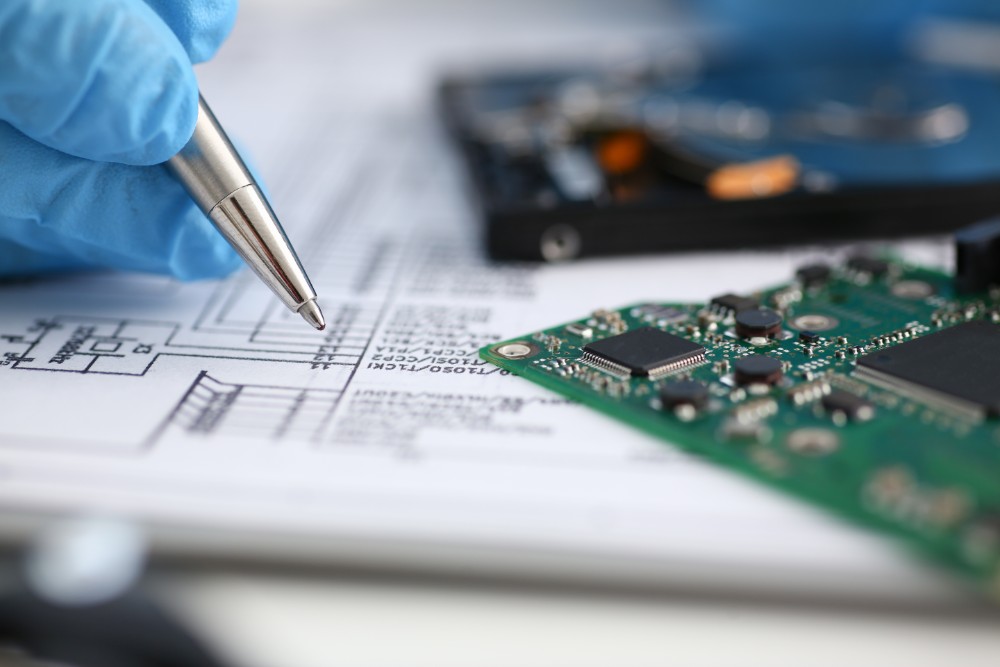Printed circuit boards are the ubiquitous components used in all electronic devices. These little boards are made of reinforced glass fiber with epoxy resin. On the outside, the PCB has a layer called the solder mask. It is the solder mask that gives the boards their iconic green color. With all of the different colors available, why was green chosen to be the standard color?
Top 4 Possible Reasons Why the Majority of the PCBs are Green
There are a few different reasons why green is the color of most PCBs. While there are other colors available, motherboards and other key PCBs are almost always green.
Materials Used in Making Solder Mask are Naturally Green
One reason is that the solder mask used on PCBs is green. The glass epoxy has a natural green tint to it, and many use this color because it is so commonplace. The color of the board does not affect the efficiency of the board, but it does affect the resolution, which is the precision of the board. While green boards do not make a difference in how devices work, green solder masks do make a difference. The green solder mask dams better than other colors, at 0.1mm, when compared to primary colors that dam at 0.12mm, and black and white which dam at 0.15mm.
The Military’s Role in PCB Development
Some believe that the green color was chosen and made standard because of the military. The United States military studied PCB colors and found that green was the most effective color, especially when they tested them in adverse situations.
Because of their tests, the military decided that green printed circuit boards would be the norm. And, the pcb manufacturers who supplied circuit boards to the military had several non-military customers, too. Businesses didn’t need to make them in different colors, because most PCBs aren’t seen by anyone other than the manufacturers.
Green is Visually Superior & Helps Relieve Fatigue
According to research, green is the easiest color for the human eye to see. It is a mixture of red and blue. Because green exists near the middle of the color spectrum at 555 nanometers, the primary colors that make green are easier for the human eye to perceive. So, when looking at something small and complicated, like a PCB, choosing green makes sense.
The human eye is easily strained by looking at something like a PCB. Green reduces eye strain, so employees tasked with inspecting PCBs can do it without their eyes becoming tired. They can see all of the parts of the PCB and conduct effective manual screening. Other colors tire the eyes more frequently. Using green creates a noticeable contrast between the green of the solder mask and the traces, pads, and silk screening.
Choosing Green as the Color for PCBs is Cheaper
Because manufacturers of all types are concerned with costs, green PCBs became the norm. In a nutshell, green is a less expensive color to use than the others that are available.
Do Printed Circuit Boards Have to be Green?
While most PCBs are green, they do not have to be in that color. While making a PCB, the color does not have any impact on the performance of the board and the device it will power. But, the resolution of it changes. This means the solder mask is more difficult to see on different colored boards. Along with green, the other more commonly used colors include red, blue, black, and white. But, all the colors of the rainbow do show up on some circuit boards.
The different colors are often coded to special parts of the device. For example, in computers, motherboards are generally coded green. This helps people who work on computers quickly identify the most important PCB on their computers. Other boards for smaller tasks are often different colors to show what they do.
Circuit boards of different colors are not as easy to work with when compared to green ones. For example, black circuit boards struggle with the heat that is used to press them together.; it often gets overheated. White boards are difficult to read. Red is easy to use because so many colors stand out on it. Blue also works well and is easy on the eyes.
Different Colors Do Not Affect How the Boards are Manufactured
Different colors do not affect the way PCBs are manufactured. Copper is still placed on one or both sides, and as the copper is added or removed, the PCB becomes smooth. The layer of copper on a PCB is incredibly thin, which is why the green color stands out so much.
The thin layer of copper is eventually covered during the soldering process to prevent it from oxidizing. The solder mask does this, and in many cases, it also comes standard in green. In other colors, the copper doesn’t show up clearly, making it tough to see where the traces are.
Once the traces are drawn, the components are put into place. These need to be soldered into place based on the map of the board. Eventually, after the components are put in place, the board is tested. If it works, they are put into production.
Most printed circuit boards need to be designed by engineers, and prototypes need to be made before they are put into production.
PCBs are usually made of green for several reasons. There are several important reasons why green is the standard for circuit boards. The color is gentle on the eyes, and it lets inspectors get a better look at the components and traces on the board. PCBs do not have to be green, but changing the color might subtly slow down production as the different colors are not as easy on the eyes as green.

